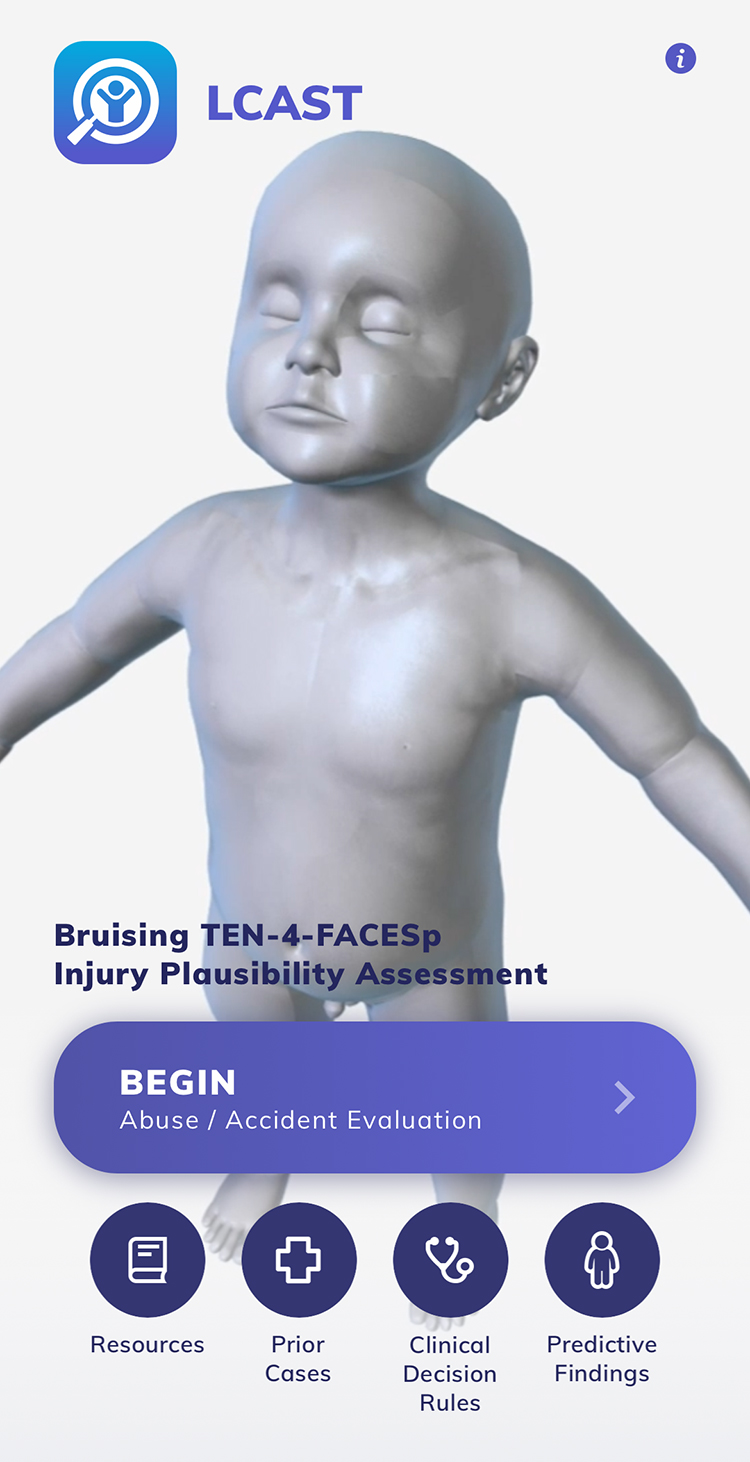
A new smartphone app may improve early recognition of physical child abuse. By applying an evidence-based strategy, the app can help healthcare providers and social workers evaluate bruising on children younger than 4 years of age and identify cases that may need further investigation for child abuse.
The Lurie Children’s Child Injury Plausibility Assessment Support Tool (LCAST) app 
“I am excited to see these research findings translated into an easy-to-use clinical decision tool. While LCAST cannot diagnose abuse, it can help providers decide when further evaluation is necessary or when abuse is less likely,” says Leah Gilbert, M.D., a medical officer in NICHD’s Pediatric Trauma and Critical Illness Branch, which funded the research. “Early detection of child abuse can prevent additional trauma and save lives.”
Bruising: An Often-Overlooked Sign of Abuse
Bruising on a young child is often dismissed as an accidental injury but, depending on its location and other characteristics, it can be an early sign of physical abuse. Because such abuse tends to escalate over time, early recognition is important for preventing subsequent injuries and death.
An effective child abuse screening technique must have a high level of both sensitivity—the ability to reliably detect children at high risk for abuse—and specificity—the ability to reliably exclude children who are not being abused. Unnecessary child abuse investigations can be difficult and highly disruptive for the child and their entire family.
Based on data collected from a small group of children in a single pediatric intensive care unit, Dr. Pierce and colleagues developed the “TEN-4” rule. This clinical decision-making guide states that bruising to the Torso, Ears, or Neck (“TEN”) or any bruising on an infant younger than 4 months old (“4”) may indicate child abuse rather than accidental injury.
Fine-Tuning Abuse Screening for Young Children with Bruising
To refine and validate the TEN-4 rule, the researchers screened children under age 4 years at five pediatric emergency departments. They enrolled more than 2,100 children with bruising into the study. Each participant received a thorough skin examination, and an expert panel classified their case information as abuse, non-abuse, or indeterminate.
In this study population, the TEN-4 rule correctly identified 331 of 410 participants who had been abused. These data translated to a sensitivity of 80.7%, meaning that the rule missed about 19% of participants who had been abused.
The researchers then refined the TEN-4 rule by changing the infant age threshold from younger than 4 months to 4.99 months and younger, and adding bruising on facial features and patterned bruising, such as when the shape of the hand is visible on the child’s skin. They dubbed the revised rule “TEN-4-FACESp.” “FACES” stands for Frenulum (the skin between the upper lip and gum, the lower lip and gum, and under the tongue), Angle of jaw, Cheeks, Eyelids, and Subconjunctivae (the whites of the eyes), and “p” for patterned bruising.
Among children in the study, TEN-4-FACESp detected potential abuse with a high sensitivity of 95.6%. The specificity was 87.1%, indicating that the rule did not over-identify as potential abuse cases of children with bruising caused by accidental injury.
Developing an App to Aid Decision-Making
With funding from a private donor, Dr. Pierce and her colleague Kim Kaczor, M.S., partnered with the companies Slingshot 

“We hope that LCAST’s practicality and ease of use will make it a convenient tool to help healthcare and social workers identify cases of potential physical abuse of infants and young children with bruising. While LCAST is based on highly reliable scientific evidence, it is intended to support—not supplant—clinical judgement,” says Dr. Pierce. “Ultimately, making it easier to identify abuse early will help children who experience abuse receive the care and support they need.”
The LCAST app is available for free download in the Apple App Store 


Screen shot of the LCAST app.
Credit: Mary C. Pierce, M.D., Lurie Children’s
References
Pierce MC et al. Validation of a clinical decision rule to predict abuse in young children based on bruising characteristics 
Pierce MC et al. Bruising characteristics discriminating physical child abuse from accidental trauma. Pediatrics DOI: 10.1542/peds.2008-3632 (2010)

 BACK TO TOP
BACK TO TOP